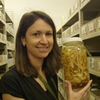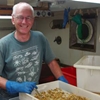General Description
Chelipeds (claws) subequal, with dense setae covering red-tipped spines. Moveable plate attached to base of eye stalks (ocular scales) with about 4 apical spines. Rostrum narrow, exceeding lateral projections. Up to 4 cm total length.
Biology
All hermit crabs have a twisted soft abdomen protected by an empty shell into which the animal can retreat when threatened. The opening to the shell is closed by the strong claws of the crab to protect the rest of the body and the animal can be almost impossible to dislodge. As the hermit crab grows, it must find a larger shell and in some dense populations, fighting for shells is a frequent event.
Habitat
Subtidal in rocks, to depths of 25 m.
Reefs
Soft substrates
Distribution guide
Southern temperate oceans, including southern Australia.
Species Group
Depth
Water Column
Max Size
4 cm
Diet
Organic matter
Harmful
Not harmful but a nip from large claws could be painful
Commercial Species
No
Global Dispersal
Recorded in Australia
Conservation Status
- DSE Advisory List : Not listed
- EPBC Act 1999 : Not listed
- IUCN Red List : Not listed







